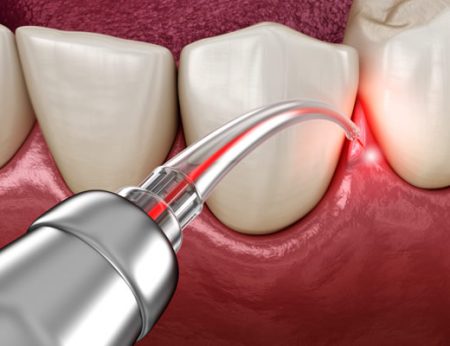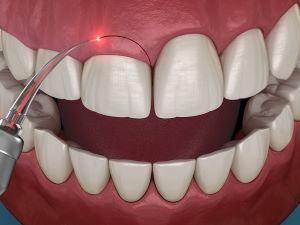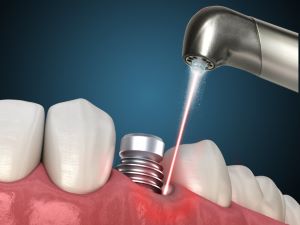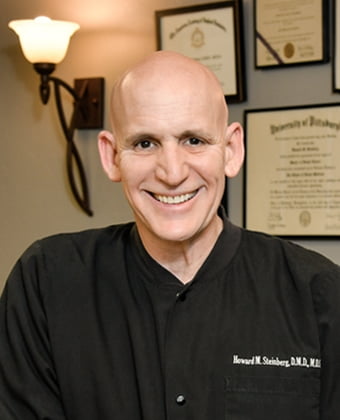Laser Dentistry
Dr. Howard M. Steinberg provides laser dentistry in Tucson, Arizona. As an experienced laser dentist, Dr. Steinberg was among the first to use dental lasers in Tucson, AZ. He introduced the Waterlase™ Er,Cr:YSGG dental laser to his practice back in 2004. Today, Dr. Steinberg and his team use a variety of modern dental lasers to perform dentistry more efficiently, with less tissue trauma and greater patient comfort.
What is Laser Dentistry?
Laser dentistry is the use of laser energy to perform dental treatment in a safe, efficient and minimally invasive manner. Dental lasers are used for procedures once thought only possible with high-speed drills, scalers and scalpels. Instead of mechanical drilling, scaling or slicing, a dental laser emits a highly focused beam of light that operates more precisely and with less tissue trauma. The first laser developed specifically for the dental market was introduced in 1990. Today, several brands and various types of lasers are used in dentistry. Laser dentistry has significant advantages over traditional dentistry. Using a dental laser, a trained laser dentist or hygienist can perform procedures with greater precision, less pain, less bleeding and less anxiety for the patient.
Dental lasers are used for procedures once thought only possible with high-speed drills, scalers and scalpels. Instead of mechanical drilling, scaling or slicing, a dental laser emits a highly focused beam of light that operates more precisely and with less tissue trauma. The first laser developed specifically for the dental market was introduced in 1990. Today, several brands and various types of lasers are used in dentistry. Laser dentistry has significant advantages over traditional dentistry. Using a dental laser, a trained laser dentist or hygienist can perform procedures with greater precision, less pain, less bleeding and less anxiety for the patient.
Dental Laser Procedures
Dr. Howard M. Steinberg and his team perform a number of common and advanced dental laser procedures in Tucson, AZ. Click on the images below to learn more.
Lasers and Periodontal Disease
There is compelling evidence that using a dental laser produces superior results in the treatment of periodontal disease. One study showed patients that received diode laser treatment of periodontal pockets exhibited a much lower bacterial count. The index of bleeding on probing improved in 96.9% in the laser group, whereas only 66.7% improved in the group not treated with the laser. See study details.
Is the Dental Laser Painless?
A number of studies investigating pain perception among patients undergoing laser treatment have been published. One clinical study using the Er,Cr:YSGG dental laser in cavity preparation showed that 80% of patients felt no significant pain or discomfort with the laser. No local anesthetic was used. Only 23% reported feeling slight discomfort during dental laser cavity preparation. See study details.
Advantages of Laser Dentistry
- Less Pain
Laser Dentistry is perceived as being less painful or painless by many patients. This is because laser energy actually has the effect of reducing nerve impulses in the treatment area and temporarily anesthetizing the tissues. This is similar to the effects of a local anesthetic shot. With the nerve cells less sensitive and conducting fewer impulses, the patient feels little to no pain during dental laser procedures. With laser dentistry, there is often no need for a local anesthetic.
- Minimally Invasive
Laser dentistry allows dentists and hygienists to perform procedures in a conservative or “minimally invasive” manner. Unlike the aggressive treatments performed with mechanical dental tools, lasers target specific tissues with pinpoint accuracy while preserving nearby healthy tissues. The dental laser can make precise, shallow cuts in soft oral tissues without the bleeding associated with deep scalpel incisions. Dental lasers can accurately vaporize diseased enamel and dentin in teeth without damaging nearby healthy tooth structure. Due to the laser’s ability to target specific tissues, there is less danger of harming healthy tissues or vital dental pulp.
- Greater Precision
Due to tissue-specific targeting and adjustable energy emission levels, a dental laser provides greater precision when performing dental procedures. Unlike mechanical dental tools that aggressively remove large amounts of tissue, a dental laser targets only the desired type and amount of tissue. Dental lasers have the ability to cut only a few millimeters deep in soft oral tissue or vaporize a tiny fraction of hard tooth enamel, dentin or bone tissue. This enhanced level of precision saves time and results in less collateral tissue damage.
- Less Bleeding
Laser dentistry results in less bleeding. Many surgical dental procedures cause bleeding, and it can be difficult to control or remove blood to maintain a dry surgical site. Because of its unique coagulating properties, laser energy reduces and, in some cases, eliminates bleeding. As it penetrates soft oral tissues, the laser energy is absorbed by the hemoglobin in red blood cells which causes coagulation. This coagulation seals off small blood vessels, reducing bleeding and allowing the dentist to better view the treatment area during laser surgery. Less bleeding saves time and sutures (stitches) are rarely needed.
- Less Postoperative Inflammation
When performing surgical procedures on soft oral tissues, laser dentistry causes less postoperative inflammation or swelling. Less tissue inflammation means less pain after the procedure. Unlike a scalpel that can tear or bruise soft oral tissues, a dental laser gently and precisely cuts tissues with a highly focused beam of light energy. Reduced trauma to the tissue means less inflammation, less postoperative pain and a reduced need for analgesics (pain medicine) after laser procedures.
- Reduced Risk of Infection
Dental laser energy sterilizes tissues, reducing the risk of infection. The laser’s high intensity light destroys surface bacteria producing a sanitizing effect. With conventional dental tools and surgical instruments, there is always the risk of transferring bacteria that can cause infection. Since dental lasers don’t actually make direct contact with tissues and function with single-use disposable tips, there is little risk of cross-contamination or tissue infection. With laser dentistry, the chance of causing infection is greatly reduced.
- Less Time
Laser dentistry takes less time. Many dental procedures can be performed more efficiently and with fewer complications when using a dental laser. Because laser energy causes less bleeding, less time is spent maintaining a dry surgical site. Dental laser procedures done on soft oral tissues usually do not require sutures (stitches). Other time-saving advantages of laser dentistry include greater precision, a reduced need for local anesthetic, less postoperative inflammation and a reduced risk of infection.
Types of Dental Lasers
- CO2
The CO2 dental laser uses a gas discharge medium containing a mixture of carbon dioxide and other gases. When stimulated, the gas produces a beam of infrared light. The CO2 wavelength is well absorbed by water molecules, making CO2 lasers effective for many soft and hard tissue dental procedures. There are two basic CO2 dental laser wavelengths (9,300 nm and 10,600 nm). The newer micro-pulsed CO2 dental lasers offer even greater control of the laser energy making it possible to use them in a broader range of dental applications.
- Diode
Diode lasers are unique in that they are powered by a semiconductor chip rather than a gas or crystal medium. Diode dental lasers operate at various wavelengths (805 nm to 1064 nm) and in multiple modes. Diode dental lasers are small, portable devices that can be pulsed at specific intervals with higher settings and longer application time. Diode laser energy penetrates deep into soft oral tissues but is poorly absorbed by hard tissues. Diode dental lasers are useful for periodontal therapy, in tissue decontamination and for procedures involving soft oral tissues.
- Er:YAG
The Er:YAG dental laser has an active solid crystal medium of yttrium aluminum garnet doped with erbium. This erbium dental laser was originally designed for use on hard oral tissues such as tooth enamel and dentin. The Er:YAG wavelength (2940 nm) is highly absorbed by water found in enamel, dentin and bone tissues. It has a strong bactericidal effect. The Er:YAG laser is used in various hard tissue dental procedures but is especially useful for treatment of tooth enamel, sterilizing infected tissues and for decontaminating dental implant surfaces in cases of peri-implant disease.
- Er,Cr:YSGG
The Er,Cr:YSGG dental laser has a solid crystal medium of yttrium scandium gallium garnet doped with both erbium and chromium. The Er,Cr:YSGG is an erbium dental laser with a wavelength (2780 nm) that is especially absorbed by water existing in both hard and soft oral tissues. Through a “hydro-photonic” process, the energy from the Er,Cr:YSGG laser interacts with water (H2O) to create molecule excitation, micro-expansion and propulsion. The Er,Cr:YSGG is an all-tissue dental laser used in many procedures including cutting, contouring and resecting bone tissues.
- Nd:YAG
The Nd:YAG dental laser has a solid crystal medium, which is a garnet crystal combined with the elements yttrium and aluminum, doped with neodymium ions. The Nd:YAG is a free-running pulsed laser. The laser energy is emitted in short bursts rather than as a continuous beam. The Nd:YAG laser wavelength (1064 nm) is highly absorbed in melanin, less absorbed in hemoglobin and only slightly absorbed in water. The Nd:YAG dental laser is used in soft tissue surgical procedures such as gum reshaping and for disinfecting oral tissues.
Experience laser dentistry in Tucson, AZ
The benefits of laser dentistry include less pain, less bleeding, less tissue trauma and less postoperative discomfort. Contact Dr. Howard M. Steinberg in Tucson, Arizona to find out if laser dentistry is right for you.
To find out more about laser dentistry, request a complimentary, no obligation consultation.
Get Started












